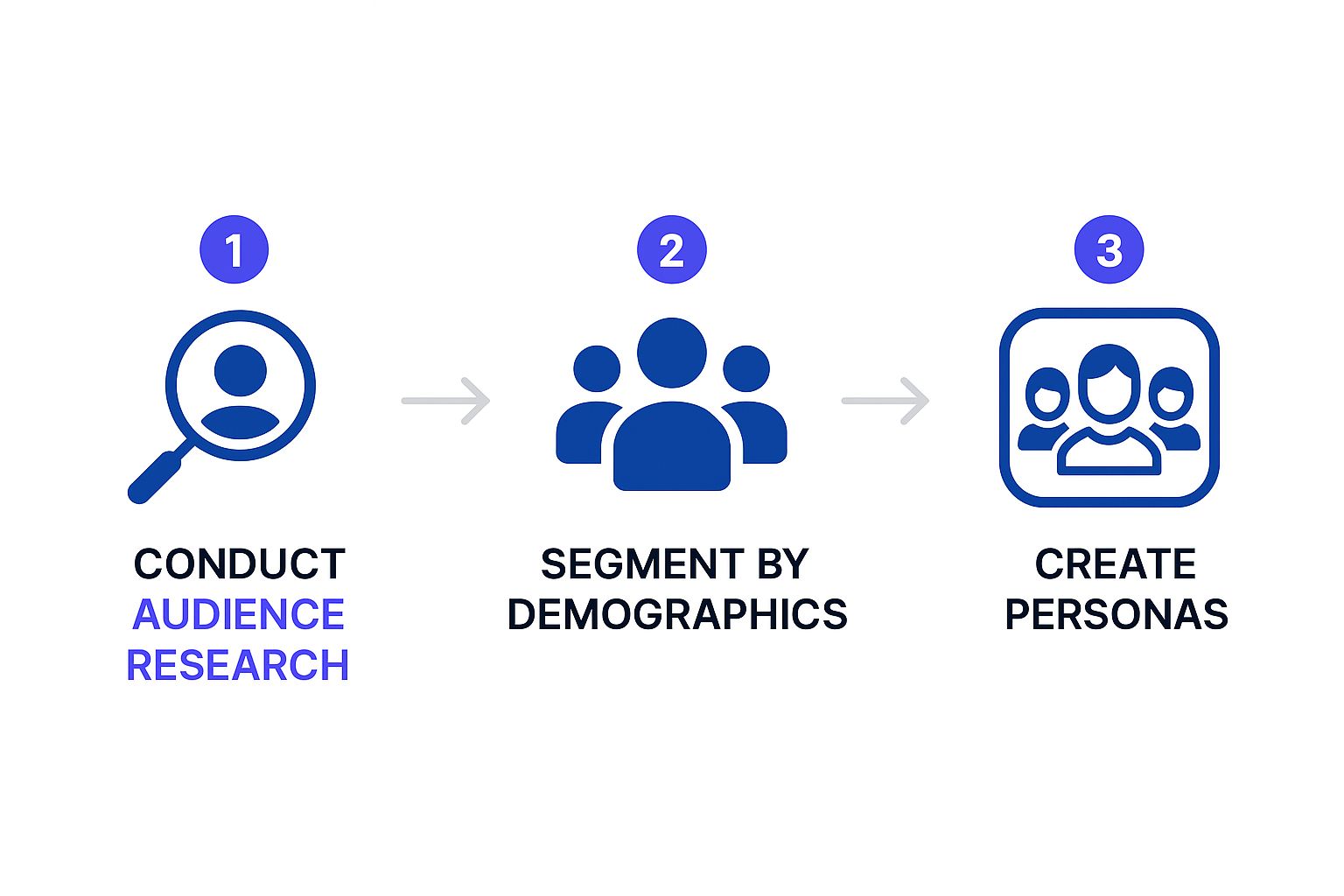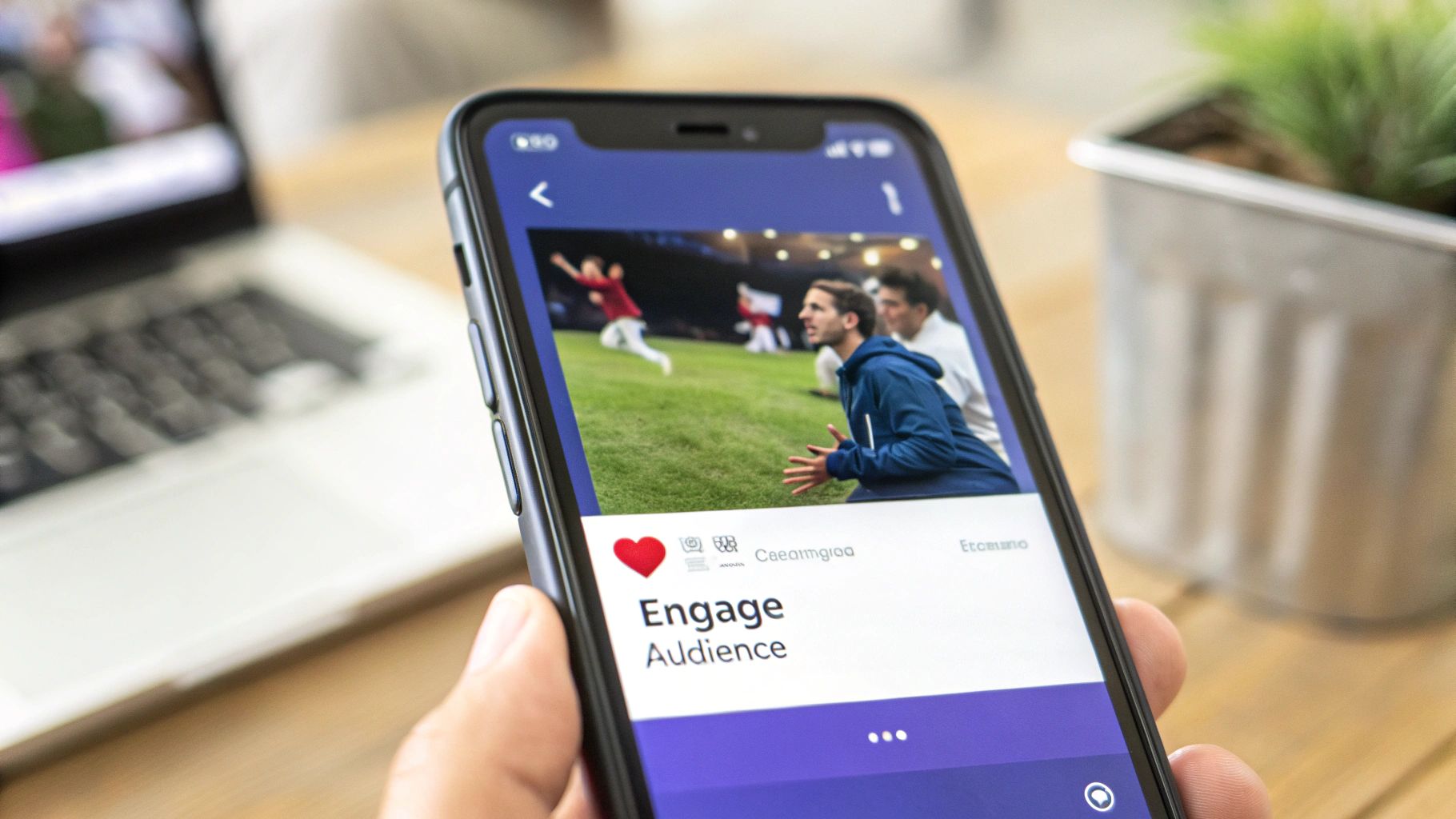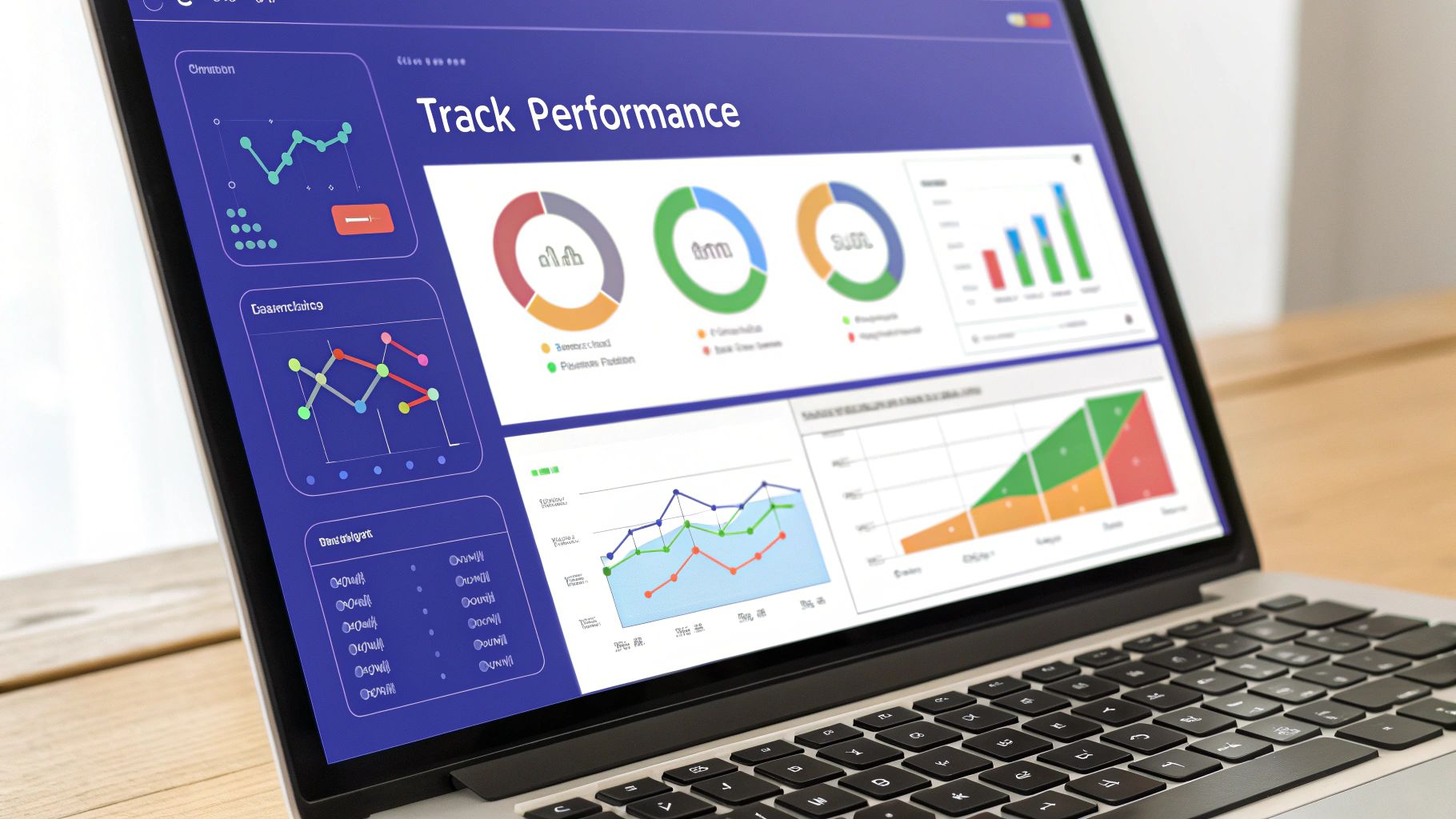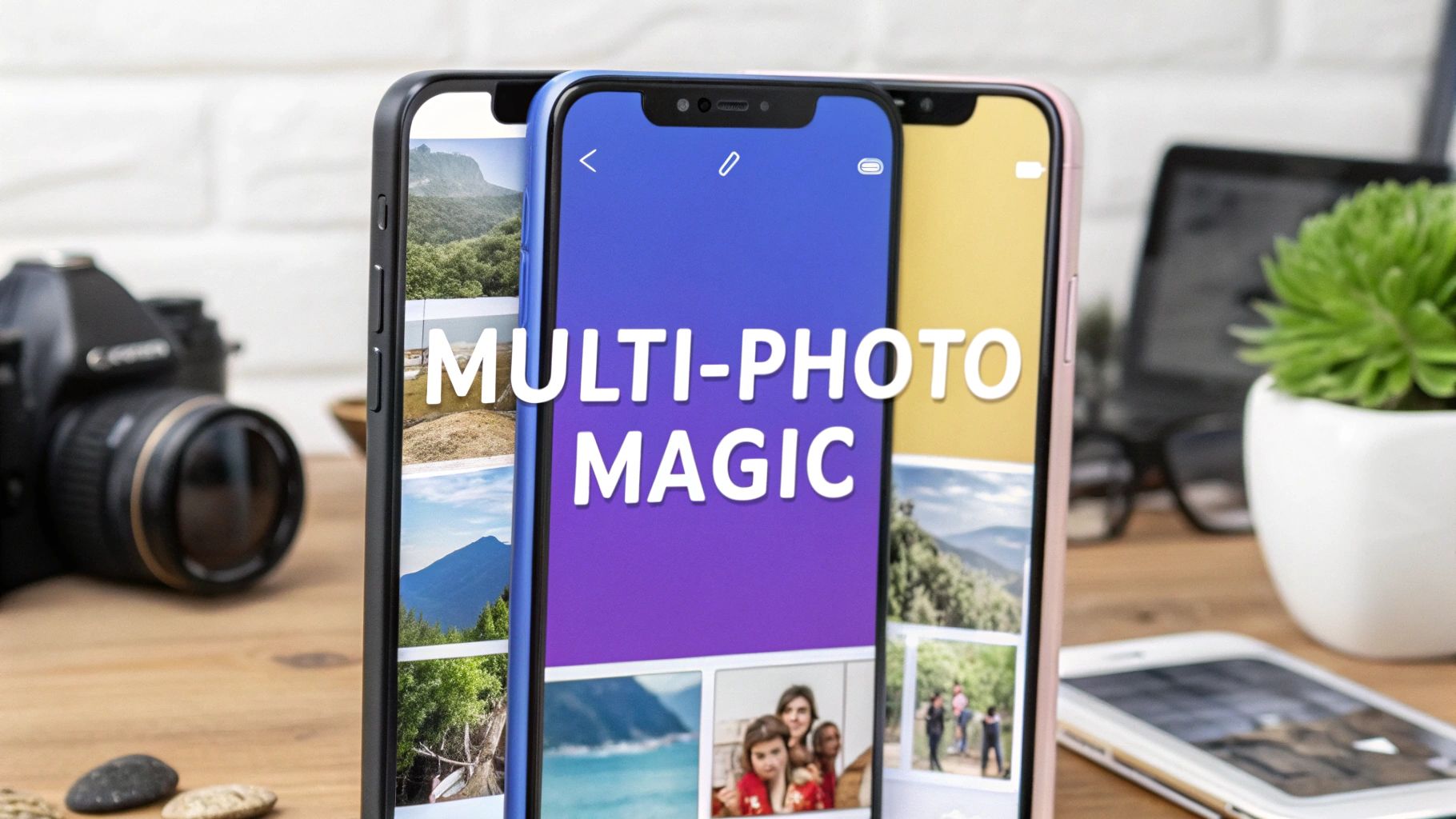A social media marketing strategy is really just your brand’s documented game plan. It outlines what you want to achieve on social media, the specific actions you’ll take to get there, and how you’ll measure success along the way. Think of it as a GPS for your digital presence—it makes sure every single post, comment, and campaign has a purpose and contributes to real business goals.
Why Your Business Needs a Social Media Strategy
Jumping onto social media without a plan is like setting sail without a map. Sure, you might float around and stumble upon some interesting things, but you’ll never reach a specific, valuable destination. A formal strategy is what turns random, hopeful posts into a coordinated effort with a clear path to success.
So many businesses fall into the trap of using social media as a last-minute broadcast channel, only posting when they have a big announcement. This almost always leads to a messy, inconsistent feed that doesn’t really connect with anyone. A documented strategy forces you to shift from chaotic, reactive posting to a proactive, goal-oriented mindset.
From Chaos to Coordinated Action
Your strategy is the blueprint for the community you want to build online. It clearly defines who you're talking to, what you'll discuss, and why it even matters to them (and your business). This clarity is what keeps your brand’s voice consistent across every platform and gets your whole team pulling in the same direction. It’s how you avoid that all-too-common feeling of a social presence that’s disjointed and off-brand.
This is more important than ever. With roughly 5.42 billion people using social media worldwide, the opportunity is massive. But here's the catch: those users are spread across an average of 6.83 different social networks each month. Your message can easily get lost in the noise if it isn’t sharp and focused. The fact that social advertising has become a $276.7 billion industry shows just how hard businesses are fighting for that attention. For more on the numbers, check out these insightful social media statistics.
A strategy provides the "why" behind every post. It ensures you're not just adding to the digital noise but are actively building relationships, generating leads, and driving revenue. It's the difference between being busy on social media and being effective.
To truly understand what a social media strategy can do for your business, it helps to see its core elements laid out. These are the pillars that hold up any successful plan, turning abstract goals into concrete actions.
Here’s a breakdown of what every solid strategy should include:
Core Components of a Social Media Strategy
A summary of the essential pillars that constitute a comprehensive social media marketing strategy.
| Component | Description | Key Question to Answer |
|---|---|---|
| Audience Personas | Detailed profiles of your ideal customers, including demographics, pain points, and online behaviors. | Who are we trying to reach? |
| Goals & Objectives | Specific, measurable, achievable, relevant, and time-bound (SMART) goals tied to business outcomes. | What do we want to accomplish? |
| Content Pillars | The key themes or topics your brand will consistently talk about to provide value and build authority. | What will our content be about? |
| Platform Selection | Choosing the right social networks where your target audience is most active and engaged. | Where will we focus our efforts? |
| Voice & Tone | The distinct personality your brand will use in all communications to sound authentic and relatable. | How will our brand sound? |
| KPIs & Metrics | The specific data points you will track to measure progress against your goals (e.g., engagement rate, conversions). | How will we measure success? |
Each of these components works together to create a cohesive and powerful plan. When you know who you’re talking to and what you want to achieve, the rest of the pieces fall into place much more easily.
A Foundation for Measurable Growth
At the end of the day, a strong social media marketing strategy is what makes your work justifiable and your growth measurable. It connects your daily social activities to real business objectives—like getting more customers or increasing sales—by establishing clear Key Performance Indicators (KPIs). This data-driven approach lets you prove the value of your efforts and make smart decisions to improve future campaigns.
It’s this fundamental understanding that makes social media work, even for niche businesses. For a great real-world example, you can see how these principles apply by looking into social media marketing for lash artists and how to attract more clients. This strategic foundation is what transforms social media from a time-consuming chore into a powerful engine for business growth.
How to Build Your Strategy from Scratch
This is where the magic happens. We're moving from theory and ideas to a concrete action plan that gets real results. Building a strategy from the ground up can feel like a huge task, but it's really just a logical process. Think of it like building a house: you need a solid foundation before you can even dream about paint colors and furniture.
This framework makes sure you cover all the important bases, turning your ambitions into a step-by-step plan that actually drives your business forward. Let's start with the cornerstone of any great strategy: figuring out what success really looks like.
Set SMART Goals to Define Your Destination
Before you even think about creating your first post, you have to know what you're trying to accomplish. Vague goals like "get more followers" or "increase engagement" aren't goals; they're wishes. To give them some teeth, they need to be SMART goals.
This isn't just another business acronym; it's a filter to make your objectives powerful.
- Specific: Nail down exactly what you want. Instead of "increase brand awareness," a better goal is "grow our Instagram follower count in our target demographic."
- Measurable: You have to be able to track it with numbers. "Grow our Instagram follower count by 1,000" is measurable. "Grow our following" is not.
- Achievable: Be real with yourself. If you have 100 followers today, aiming for one million by next month is just setting yourself up for failure.
- Relevant: Your social media goals have to connect to your bigger business objectives. Does growing your follower count actually help with bigger goals like getting more website traffic or generating sales leads?
- Time-bound: Every goal needs a finish line. "Grow our Instagram follower count by 1,000 within the next quarter" creates urgency and a clear timeline to see if you made it.
Setting SMART goals turns fuzzy ambitions into a clear roadmap. It’s the difference between wandering around aimlessly and navigating with a GPS pointed directly at your destination.
Define and Understand Your Target Audience
You can't create content that connects if you don't know who you're talking to. Shouting into the void is a massive waste of time and money. What you need are detailed buyer personas—these are fictional, yet realistic, profiles of your ideal customers built on real data and market research.
The process starts broad and gets sharper as you go. This visual breaks down the simple three-step flow from general research to a detailed persona you can actually use.

As you can see, you start with wide-ranging audience research, narrow it down by segmenting key groups, and then build specific, actionable personas. A good persona isn't just a list of data points; it's a story about a person.
To build out your personas, you need to answer questions like:
- What are their biggest headaches and challenges?
- Which social media apps are they scrolling through every day?
- What kind of content do they actually stop and consume?
- Why would they even follow a brand like yours in the first place?
Answering these questions helps you create content that speaks directly to their needs. Your brand starts to feel less like a faceless company and more like a trusted guide.
Conduct a Competitive Analysis
You're not operating in a bubble. Your competitors are all fighting for your audience's attention, and you can learn a ton from what they're doing right—and wrong. A competitive analysis isn't about copying their every move; it's about finding gaps and opportunities they've missed.
Start by picking 3-5 of your main competitors. Then, go deep on their social media presence, asking:
- Which platforms are they on? Where are they most active, and where do they seem to be getting the best results?
- What's their content strategy? What topics do they post about? What's their mix of video, images, and text-only posts?
- What's their engagement like? Which posts get the most likes, comments, and shares? And more importantly, why?
- Where are they weak? Are they slow to respond to comments? Is their content boring and uninspired? This is your chance to shine.
This analysis gives you a benchmark and, better yet, exposes golden opportunities. If all your competitors are ignoring TikTok but you know your audience lives there, you’ve just found a wide-open field to dominate.
A competitive analysis gives you a strategic edge. It lets you learn from your rivals' investments and mistakes, so you can enter the conversation with a smarter, more refined social media marketing strategy.
Choose the Right Platforms
One of the most common mistakes is trying to be everywhere at once. Spreading yourself too thin across every social network is a surefire way to get mediocre results everywhere. Instead, focus your energy on the platforms where your target audience—those personas you just built—actually hangs out.
For example, a B2B software company will almost certainly get more bang for their buck on LinkedIn than on Pinterest. On the flip side, a brand selling home decor will crush it on visual-first platforms like Instagram and Pinterest. The golden rule is simple: be where your customers are.
Establish Your Key Performance Indicators
So, how will you know if any of this is actually working? This brings us full circle back to your SMART goals. For each goal you set, you need to define the Key Performance Indicators (KPIs) you'll track to measure your success.
Here’s how goals and KPIs connect:
| SMART Goal | Corresponding KPI to Track |
|---|---|
| Increase Brand Awareness | Reach, Impressions, Follower Growth Rate |
| Drive Website Traffic | Clicks, Social Media Referral Traffic |
| Generate Leads | Conversion Rate, Leads from Social Forms |
| Boost Engagement | Engagement Rate (Likes, Comments, Shares) |
To make sure your social media efforts fit into the bigger picture, it's smart to explore advanced digital marketing strategies that can work alongside your plan. Building the plan is a huge step, and if you need a pre-built structure to get started, this social media marketing plan template can help you organize everything perfectly.
Choosing the Right Social Media Platforms for Your Business

Here's a hard truth: where you post is just as important as what you post. A brilliant message delivered to the wrong crowd is just noise. The most critical part of any social media marketing strategy is picking the platforms where your ideal customers are already hanging out and ready to engage.
Spreading yourself thin across every platform is a classic mistake that drains your resources and guarantees you’ll be mediocre everywhere. It’s the dreaded "spray and pray" approach. Don't do it.
Think of each social platform as a different kind of party. LinkedIn is a polished professional networking event. Instagram is a visually stunning art gallery. Pinterest is a hands-on creative workshop. And TikTok? That's a high-energy, trend-driven block party. You wouldn't wear a tuxedo to the block party, right? Matching your brand’s vibe to the platform's atmosphere is everything.
Instead of trying to be everywhere, make a calculated decision. Invest your time and budget where you'll get the biggest bang for your buck.
Getting to Know the Key Players
Each platform has its own unique flavor—a distinct user base, a dominant content style, and a specific way of doing things. Your job is to find the sweet spot where a platform's strengths overlap with your business goals.
Meta (Facebook & Instagram): This powerhouse duo gives you incredible reach and some of the most sophisticated targeting tools available. Facebook is still a giant for building communities and connecting with a wide range of people, while Instagram is the undisputed champ for visual storytelling, influencer marketing, and selling products directly through the app.
LinkedIn: As the world's largest professional network, LinkedIn is the king of B2B marketing. It’s the perfect place to share deep industry insights, establish yourself as a thought leader, and connect directly with the decision-makers you need to reach.
TikTok: This platform is the absolute epicenter of short-form video and viral trends. Its discovery algorithm is ridiculously powerful, making it a goldmine for direct-to-consumer (D2C) brands wanting to connect with younger audiences through fun, authentic content.
Pinterest: Think of Pinterest as a visual search engine where people go specifically to find inspiration and plan purchases. It's a fantastic spot for brands in home decor, fashion, food, and DIY because users are there with a high intent to buy.
Platform Smackdown: Which Network Wins for Your Goal?
Not sure where to start? This table breaks down which platform is best suited for common business objectives. Think of it as your cheat sheet for making a smart, strategic choice from day one.
| Platform | Best For | Primary Audience | Key Content Format |
|---|---|---|---|
| Community Building, Brand Awareness | Broad (Gen X, Millennials) | Video, Curated Articles, Groups | |
| Visual Storytelling, E-commerce | Millennials, Gen Z | High-Quality Photos, Reels, Stories | |
| B2B Lead Gen, Thought Leadership | Professionals, B2B Decision-Makers | Articles, Case Studies, Professional Updates | |
| TikTok | Brand Awareness, Viral Marketing | Gen Z, Young Millennials | Short-Form Vertical Video, Trends |
| Driving Traffic, Product Discovery | Predominantly Female, High-Intent Shoppers | Infographics, "Pins," How-To Guides |
Ultimately, this isn't about picking the most popular platform; it's about picking the right platform for you.
Matching Platforms to Your Business Goals
Let's make this real. Imagine you run a B2B software company. Your target audience is VPs of Sales and marketing managers, and your main goal is generating leads. For you, investing heavily in LinkedIn is a no-brainer. You can publish insightful articles, share compelling case studies, and use hyper-targeted ads to reach professionals by their exact job title and industry. Wasting time on TikTok? Probably not the best use of your resources.
Now, flip the script. You're launching a new D2C fashion brand targeting Gen Z. Your goal is rapid brand awareness and driving online sales. TikTok and Instagram are your perfect match. You can work with influencers on Instagram and create viral video challenges on TikTok to show off your clothes in a fun, authentic way. LinkedIn would offer almost zero value here.
The heart of a solid platform strategy is simple: Go where your customers are, and speak their language. Don't try to force a platform to fit your brand; choose the platform that naturally amplifies it.
The sheer financial power behind these platforms underscores their importance. Social media advertising is a massive industry. Meta, with Facebook and Instagram, is a titan, pulling in over $46.8 billion in ad revenue in a single recent quarter from its 2.28 billion users. Meanwhile, TikTok has shot up to become a major player with $10 billion in annual ad revenue, and Pinterest has carved out its valuable niche with $2.8 billion. These aren't just fun apps; they are economic powerhouses. If you want to dig deeper, you can discover more powerful social media statistics that will reshape your strategy.
Choosing your platforms wisely is one of the most fundamental steps to a winning social media strategy. By focusing your efforts, you concentrate your impact, build a more loyal community, and, most importantly, drive much better results for your business.
Here is the rewritten section, crafted to sound like an experienced human expert while adhering to all the specified requirements.
Creating Content That Actually Converts
Let's be real. You can have the most brilliant social media strategy on paper—perfect audience personas, ideal platform choices—but it will completely fall flat without one thing: content that people actually want to see. Great content is the engine driving this whole machine. It’s what stops the scroll, gets people talking, builds real trust, and ultimately, nudges your audience to take action.
But "creating content" isn't about just throwing random posts at the wall and hoping something sticks. It’s a deliberate, thoughtful process. You’re crafting posts that not only get likes but actively guide followers toward becoming customers. This means every single piece of content, from a funny Reel to a deep-dive carousel, needs a purpose tied back to your business goals.
The Power of Content Pillars
To keep your feed from feeling chaotic and random, the best in the business build their strategy on content pillars. Think of these as the 3-5 core themes or topics your brand will own. They're the main subjects that your audience finds valuable and that relate directly to what you sell.
A company selling high-end kitchen knives, for instance, might build their content around these pillars:
- Educational How-Tos: Posts showing off proper knife skills or how to care for the blades.
- Recipe Inspiration: Gorgeous, drool-worthy dishes that can be made using their knives.
- Behind-the-Scenes Craftsmanship: Content that pulls back the curtain on the quality and care that goes into making each knife.
- Customer Features (UGC): Sharing photos and videos from home cooks using and loving the knives in their own kitchens.
These pillars give you a balanced content mix. You're educating, entertaining, inspiring, and selling, all without letting your feed become a repetitive sales pitch. They’re the guardrails that keep your content focused, on-brand, and consistently valuable.
Mastering Different Content Formats
Your content pillars can come to life in a bunch of different ways, and picking the right format can make all the difference. While a stunning, high-quality image is still a cornerstone of a good feed, today's social media world is all about dynamic, moving content.
Short-form video—think Instagram Reels and TikToks—is no longer just a "nice-to-have." It’s essential for getting your content seen and shared. These quick, punchy videos are an incredible way to demo products, share quick tips, or just let your brand's personality shine through.
But honestly, one of the most powerful and trusted content formats isn't even one you create yourself. It's user-generated content (UGC). This is any content—photos, videos, glowing reviews—created by your actual customers. When you feature UGC, you're tapping into the most authentic form of social proof there is.
When a potential customer sees someone just like them using and loving your product, it builds a level of trust that branded content can rarely achieve. It says, "Don't just take our word for it; look at our happy community."
Turning Your Feed into a Sales Channel
Modern social media is about so much more than just building a brand; it’s about driving sales directly. This is where social commerce steps in, transforming your social profiles from simple marketing channels into actual storefronts. By using shoppable posts and product tags, you shorten the path from discovery to purchase, letting people buy the moment they feel inspired by a post.
This isn't a small trend; it's completely reshaping online retail. In fact, social networks now drive 17.11% of all online sales. That sector is on track to explode, projected to surpass $1 trillion by 2028. A huge piece of this puzzle is influencer marketing; 49% of consumers say they make monthly purchases based on influencer recommendations. And the power of real people is undeniable, with UGC influencing the buying decisions of a massive 90% of shoppers. You can dig deeper into how social media generates real money with these social commerce statistics.
When you combine strong content pillars with a smart mix of formats like video and UGC, and then layer on social commerce tools, you create a powerful content engine. It's an engine that doesn't just collect followers; it builds a loyal community and turns them into paying customers, proving the direct value of your social media efforts.
Measuring What Matters to Optimize Your Strategy

Let’s be honest. A social media strategy without measurement is just a bunch of hopeful guesses. It’s the data—the cold, hard numbers—that transforms your plan from an idea on paper into a dynamic machine that actually drives business growth. This is where you connect your daily posts and tweets to real, bottom-line results.
So many brands get caught up chasing vanity metrics. These are the numbers that feel good but don't mean much, like likes, shares, and follower counts. Sure, they might signal some surface-level activity, but they won't tell you if your strategy is actually making you money. True optimization starts when you focus on the metrics that really matter.
Moving Beyond Vanity to Actionable KPIs
To get a real grip on your performance, you need to tie your measurements directly back to those SMART goals you set earlier. These are your Key Performance Indicators (KPIs)—the specific data points that tell you whether you’re on the right path.
It means looking past the surface and asking tougher, more valuable questions. Instead of just asking, "How many likes did this post get?" you should be asking, "How many people who saw this post clicked the link to our site and signed up for our newsletter?" See the difference?
Here are a few examples of meaningful KPIs to zero in on:
- Conversion Rate: What percentage of users take a specific action you want (like buying a product or downloading a guide) after clicking a link in your post?
- Lead Generation: How many new leads did you capture directly from social media, maybe through a lead form ad or a link to a landing page?
- Cost Per Click (CPC): If you're running ads, this shows how much you’re spending for a single click, which is crucial for gauging ad efficiency.
- Customer Acquisition Cost (CAC): This is the big one. It’s the total cost of your social media marketing divided by the number of new customers you gained from it.
Shifting your focus to these kinds of metrics is everything. It’s how you prove the ROI of your social media efforts and make smart, data-driven decisions to improve your strategy over time.
A focus on actionable KPIs turns your analytics from a simple report card into a strategic roadmap. It shows you exactly what's working, what's not, and where to invest your resources for maximum impact.
Leveraging the Right Analytics Tools
Gathering this data means you need to look in the right places. Luckily, you have some powerful tools at your fingertips, and many of them are free. Every major social platform has its own native analytics dashboard (think Meta Business Suite or LinkedIn Analytics) that serves up a ton of information on your performance.
These built-in tools are great for understanding things like reach, engagement, and audience demographics on a platform-by-platform basis. But to get the full picture, using a third-party tool like PostSyncer is a total game-changer. It pulls all your data into one place, letting you track KPIs across every network without having to jump between a dozen different tabs. That unified view is essential for efficient analysis.
Understanding how to measure social media success is the foundation for refining your strategy and actually hitting your business goals.
Establishing a Rhythm for Review and Optimization
Data is useless if you don't do anything with it. The final piece of the puzzle is creating a consistent routine for reviewing your performance and tweaking your approach. Don't wait until the end of the quarter to find out a campaign has been flopping for weeks.
Set up a regular review cycle. A weekly check-in is perfect for active campaigns, while a monthly meeting works well for a higher-level strategic overview. During these reviews, dig into your KPIs, find your top-performing content, and pinpoint what needs to be improved. This continuous feedback loop is the engine of a successful and adaptable social media strategy. For a more detailed look, our guide offers specific tips on how to measure social media success and turn those numbers into action.
Streamlining Your Strategy with PostSyncer
Building a killer social media strategy is a huge win, but let's be honest—the real battle is executing it day in and day out. This is where theory crashes into reality. It’s also where a smart tool like PostSyncer becomes your secret weapon, turning that brilliant plan into consistent, manageable action.
Think of PostSyncer as the command center for your entire strategy. It takes all those concepts we just covered—like your content pillars and platform choices—and plugs them into a real-world workflow. Instead of drowning in spreadsheets, multiple browser tabs, and scattered documents, you get to bring every piece of your plan under one simple roof.
From Plan to Post Without the Headaches
A great strategy is worthless without consistent execution. This is where most people get stuck.
PostSyncer's content calendar lets you visually map out your entire schedule across all your networks. You can see at a glance if your content pillars are balanced and if your posting frequency is on track. That daily scramble of "What do I post today?" is officially over.
The platform's analytics dashboard is where the magic really happens. It pulls performance data from all your channels and translates it into simple, actionable insights that directly tie back to the KPIs you set. You can finally stop guessing and start making sharp, data-backed decisions to fine-tune what's working and ditch what isn't.
Here’s a peek at what an integrated dashboard looks like, bringing all your planning and scheduling together.
Seeing all your scheduled content laid out like this gives you a powerful, big-picture view of your strategy in motion.
Ultimately, a tool like PostSyncer is designed to remove the friction. It ensures your social media strategy isn't just some document that collects dust, but a living, breathing engine for your business's growth.
Your Social Media Strategy Questions Answered

Even after you've built a solid plan, questions always pop up. It's totally normal. A great social media marketing strategy isn't a "set it and forget it" document; it's a living thing that needs constant attention and quick answers to new challenges.
So, let's get into some of the most common questions I hear from people once they start putting their strategy into action. We’ll tackle everything from budgeting and posting frequency to the dreaded algorithm changes.
How Much Should I Budget for Social Media?
There’s no magic number here, but a smart starting point is dedicating 5-15% of your total marketing budget to social. This should cover both creating your content and running paid ads. If you're a new business hungry for growth, you might even push that closer to 20% to really get the ball rolling.
It helps to think of your budget in two main buckets:
- Tools and Talent: This is where you account for things like scheduling software (like PostSyncer), design tools, or even hiring a freelancer to create content.
- Paid Advertising: This is the money you'll spend to boost posts, run specific campaigns, and get your brand in front of new audiences to hit your goals faster.
How Often Should I Post on Social Media?
Here’s the thing: consistency beats frequency every single time. Posting three high-quality, genuinely engaging pieces of content a week is far more powerful than spamming your followers with ten low-effort posts. The real goal is to find a rhythm you can actually maintain without burning out.
Don’t get trapped in the mindset that you need to post multiple times a day. Focus on delivering real value with every single post. Let your audience's reaction be your guide—if your posts are sparking conversations, you're on the right track.
A great way to figure this out is to track social media engagement and see which posting schedule gets the best response from your specific audience.
How Do I Adapt to Algorithm Changes?
Algorithm changes are a fact of life in social media, but they shouldn't send you into a panic. At their core, these updates are designed to show users more of what they actually want to see—valuable, authentic, and engaging content. Your best defense is simply to focus on creating exactly that.
When you notice a shift in the algorithm, take these steps:
- Don't Panic: Seriously. Avoid making huge, knee-jerk changes to your entire strategy.
- Observe and Learn: Look at what types of content are suddenly getting more reach. Is it long-form video? Is it raw, behind-the-scenes Stories?
- Experiment: Test the waters with a few posts that fit the new trend. See how your audience responds.
- Adapt, Don't Overhaul: If something works, gradually weave it into your existing content pillars. You don't have to throw out what was already working.
By keeping your audience at the heart of your strategy, you’ll naturally stay aligned with what most algorithms want. This makes your strategy resilient enough to weather any storm.
Ready to turn your strategy into action? PostSyncer provides the all-in-one platform you need to schedule content, analyze performance, and manage all your accounts from a single dashboard. Stop juggling tabs and start building momentum. Start your 7-day free trial today!















